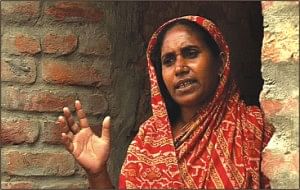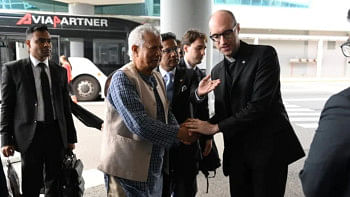“The Road to Kansat”: Upholding legacy of Kansat movement

A scene from the documentary
The nine-month general public agitation in recent times for access to electricity in the township of Kansat, Rajshahi has been unfolded by two parallel devices-- through a television journalist's conversations with the leaders of the movement, and through the traditional performing art form Gambhira-- in the documentary The Road to Kansat.
Journalist Munni Saha goes to Kansat and talks with the movement leaders Golam Rabbani, Mrs. Rabbani, Tissue Bhai, Rokeya Begum and family members of the gunshot victims. To portray the torture by the police on the participants of the non-violent movement, clippings of television reports on the movement, footage from personal collections and newspaper cuttings have been used as flashback scenes.
Besides featuring the public struggle for rights, directors of the documentary Tareque and Catherine Masud have placed specific focus on active participation of the women in nine-month movement between September 2005 and April 2006.
In fact, when movement leader Golam Rabbani was arrested, general people especially his wife Mrs. Rabbani and Rokeya Begum rose against the repressive measures. Perhaps only during the Kansat movement a remarkable number of women actively participated in the struggle. In the documentary movement leaders criticised the press for not covering the torture on women by the police.
Parallel to the journalist's interview, the Kansat movement has also been portrayed through the conversation of Nana-Nati characters of traditional art form of North Bengal Gambhira. Nana and Nati have addressed the legacy of the revolutionary character of the people of greater Rajshahi area in the documentary, however, sometimes the presentation of Gambhira appear irrelevant.
The documentary ends with a vow of the masses against injustice and corruption in public sector.
A special show of The Road to Kansat was screened on October 10 at the British Council Auditorium. The screening was followed by a discussion in which Cultural Affairs Adviser Rasheda K. Chowdhury, human rights actist Hameeda Hossain, Manusher Jonno Foundation Executive Director Shaheen Anam, Kansat movement leader Golam Rabbani and Tareque Masud delivered speeches.
Discussants at the progra-mme appreciated Tareque and Catherine Masud for making a documentary on the legacy of the public against corruption.

 For all latest news, follow The Daily Star's Google News channel.
For all latest news, follow The Daily Star's Google News channel. 



Comments